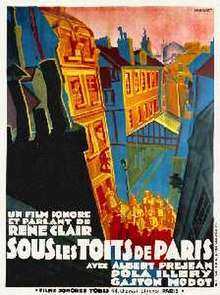Under the Roofs of Paris
| Under the Roofs of Paris | |
|---|---|

Theatrical release poster
|
|
| Directed by | René Clair |
| Produced by | Films Sonores Tobis |
| Written by | René Clair |
| Starring |
Albert Préjean Pola Illéry |
| Music by | Armand Bernard Raoul Moretti (songs) René Nazelles (songs) |
| Cinematography |
Georges Périnal Georges Raulet |
| Edited by | René Le Hénaff |
|
Release date
|
2 May 1930 (France) |
|
Running time
|
96 minutes |
| Country | France |
| Language | French Romanian |
Under the Roofs of Paris (French: Sous les toits de Paris) is a 1930 French film directed by René Clair. The film was probably the earliest French example of a filmed musical-comedy, although its often dark tone differentiates it from other instances of the genre. This was an early example of sound film in France, along with Prix de beauté and L'Âge d'or. However, Under the Roofs of Paris was the first French production of the sound film era to achieve great international success.
In a working-class district of Paris, Albert, an impecunious street singer, lives in an attic room. He meets a beautiful Romanian girl, Pola, and falls in love with her; but he is not the only one, since his best friend Louis and the gangster Fred are also under her spell. One evening Pola dares not return home because Fred has stolen her key and she does not feel safe. She spends the night with Albert who, reluctantly remaining the gentleman, sleeps on the floor and leaves his bed to Pola. They soon decide to get married, but fate prevents them when Émile, a thief, deposits with Albert a bag full of stolen goods. It is discovered by the police, and Albert is sent to prison. Pola finds consolation with Louis. Later Émile is caught in his turn and admits that Albert was not his accomplice, which earns Albert his freedom. Fred has just got back together with Pola who has fallen out with Louis, and in a jealous fury at Albert's return Fred decides to provoke a knife fight with him. Louis rushes to Albert's rescue and the two comrades are re-united, but their friendship is clouded by the realisation that each of them is in love with Pola. Finally Albert decides to give up Pola to Louis.
The arrival of synchronised sound in the cinema in the late 1920s provoked mixed reactions among French film-makers, and some of the masters of silent film technique were pessimistic about the impact it would have. In 1927, even before The Jazz Singer had been shown in Paris, René Clair wrote: "It is not without a shudder that one learns that some American manufacturers, among the most dangerous, see in the talking picture the entertainment of the future, and that they are already working to bring about this dreadful prophecy". Elsewhere he described the talking picture as "a redoubtable monster, an unnatural creation, thanks to which the screen would become poor theatre, the theatre of the poor". It was therefore an irony that it was Clair who would produce the French cinema's first big international success with a sound picture in Sous les toits de Paris.
...
Wikipedia
